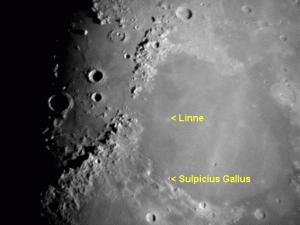The week of October 15-21 takes us from Day 6 to Day 12. This week we will highlight the crater Linné and the Sulpicius Gallus rilles.
Linné: [NE/G11] Linné is a simple, relatively young crater with an interesting history. It is only 1.5 miles in diameter (about 1.3 arc-seconds at the average distance of the Moon), which makes it about twice the size of Meteor Crater in Arizona. Linné is surrounded by very light-colored material, and, because its appearance changes so much with different angles of illumination, this was once taken as evidence that the Moon was not a totally dead place. In 1866 it was erroneously reported that Linné had vanished. The idea caught on and was cited as proof that the Moon was still geologically active. Observe Linné several times between now and full moon as the lighting angles change and see if you can convince yourself (if you didn’t know better) that Linné could disappear.
Sulpicius Gallus Rilles: [NE/G10-11] Not far from Linné in the Sea of Serenity you will find the Sulpicius Gallus Rilles. These rilles are the result of Serenity lava flows that were so heavy that the basin center subsided and opened up substantial cracks around the shore line.
OF ADDITIONAL INTEREST IN SPACE THE WEEK OF OCTOBER 15-21:
The Orionid meteor shower will occur on the morning of Ocober 21. Its parent is Comet Halley and it will have an hourly rate of 10-20 meteors. The best time to view will be a couple of hours before dawn.
======================
It is highly recommended that you get a copy of Sky and Telescope’s Field Map of the Moon, the very finest Moon map available for use at the telescope. It is available for $10.95 at www.skyandtelescope.com and on Amazon. All features mentioned in this blog will be keyed to the grid on the Field Map and will look like this: Plato: [NW/D9]
Credits:
Courtesy of Gray Photography of Corpus Christi, Texas
Lunar photos: NASA / USGS / BMDO / LROC / ASU / DLR / LOLA / Moon Globe. Used by permission
- Trio of Moon Craters with Distinct Personalities - April 22, 2024
- Hippalus Rilles on the Moon - April 15, 2024
- Moon Crater Janssen: How New Moon Craters are Superimposed on Top of Older Craters - April 8, 2024

I’m having trouble identifying Sulpicius Gallus because some put a suffix M after it, others an A or B. I can’t find reliable references online. And photos are inconsistent. Do you have a map that clearly identifies all the Supicius Gallus’s… along with the nearby Apollo 15 landing site, Serenitatus and Linnes… all in one map… and I think 1 Luna landed north of Apollo 15 and there’s Hadley-C in that neighbourhood too. What we need is a “Tourism Guide to Vacation Spots on the Moon!”. haha.